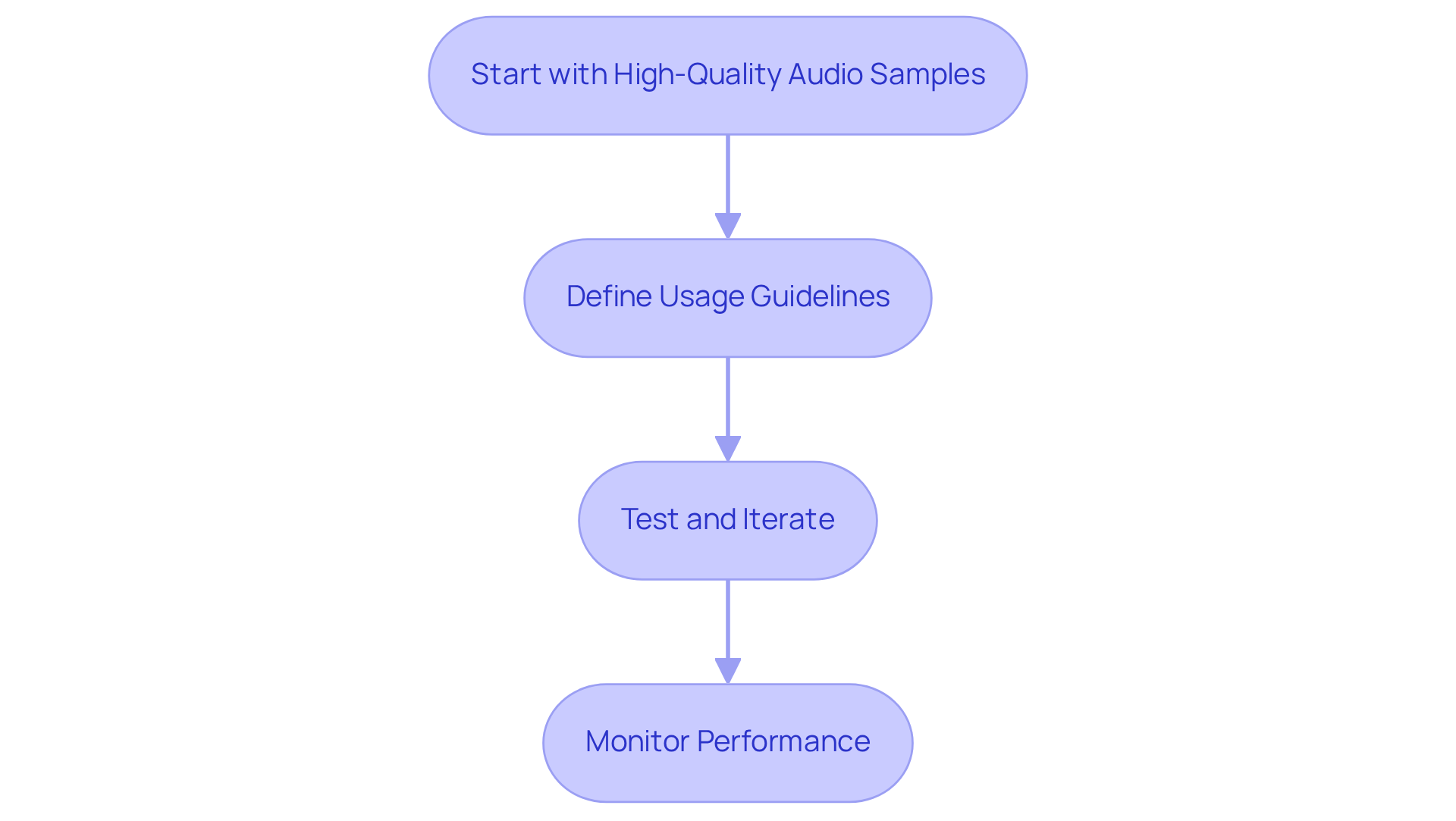
4 Best Practices for Effective Voice Clone AI Integration
GeneralOverview
To effectively integrate voice clone AI, organisations must adhere to best practises that include:
- Utilising high-quality audio samples
- Defining clear usage guidelines
- Conducting thorough testing
- Continuously monitoring performance
These practises are not just recommendations; they are essential for enhancing the quality of voice replication, preventing misuse, and ensuring that the technology aligns with organisational goals while addressing potential ethical concerns. By implementing these strategies, organisations can harness the full potential of voice clone AI, maximising its benefits while safeguarding against risks.
Introduction
In an era where technology increasingly blurs the lines between reality and simulation, voice cloning AI emerges as a groundbreaking innovation with immense potential. By leveraging advanced machine learning algorithms, businesses can craft digital replicas of human speech, revolutionising customer interactions and enhancing operational efficiency. However, as organisations eagerly adopt this cutting-edge technology, they must navigate a complex landscape of ethical concerns and practical challenges.
How can companies effectively integrate voice cloning while ensuring responsible use and upholding trust? The answer lies in a balanced approach that prioritises ethical considerations alongside technological advancement.
Understand Voice Cloning Technology
Vocal cloning methods utilise voice clone AI and advanced machine learning algorithms to create a digital replica of an individual’s speech. This intricate process involves analysing audio samples to capture unique characteristics such as tone, pitch, and cadence. The resulting system that incorporates voice clone AI can produce speech that closely mimics the original speaker’s tone, facilitating applications across various commercial settings—from customer support to advertising. Agentics is pivotal in revolutionising corporate communication through tailored artificial intelligence solutions that enhance efficiency and customer engagement.
Understanding the technical nuances, particularly the distinction between text-to-speech and vocal replication, is essential for companies aiming to leverage this innovation effectively. While text-to-speech generates synthetic sounds from written text, vocal replication relies on actual audio samples to produce a more authentic sound. Familiarity with these differences empowers organisations to select the appropriate tools and strategies tailored to their specific needs.
To fully harness the advantages of voice clone AI technology, enterprises must adopt best practises, including:
- Ensuring high-quality audio samples
- Regularly updating sound models
- Seamlessly integrating voice clone AI solutions into existing workflows
By doing so, businesses can optimise their communication strategies and significantly enhance customer interactions.
Explore Benefits of Voice Cloning in Business
Voice clone AI presents a transformative opportunity for businesses, providing enhanced personalization, significant cost savings, and improved efficiency. Companies can leverage voice clone AI to create speech replicas that foster personalised customer interactions, making communications feel more human and engaging. This innovation not only reduces the need for live performers in marketing campaigns—thereby dramatically cutting expenses—but also streamlines operations by automating repetitive tasks, such as customer service inquiries. As a result, human agents can focus on more complex issues.
A compelling case study from a leading customer service provider revealed a 30% reduction in response times following the implementation of audio replication methods, which in turn led to heightened customer satisfaction rates. By harnessing these advantages, companies position themselves to gain a competitive edge in their respective markets.
Implement Best Practices for Voice Cloning Integration
To effectively integrate speech replication technology, businesses must adhere to several best practices.
- Start with High-Quality Audio Samples: It is essential to use clear audio samples devoid of background noise. This foundational step significantly enhances the quality of the replicated sound.
- Define Usage Guidelines: Establishing unambiguous guidelines regarding who can utilize the clone and for what purposes is crucial. This measure not only prevents misuse but also upholds brand integrity.
- Test and Iterate: Prior to full deployment, conducting tests to assess the audio clone’s effectiveness in real-world scenarios is vital. Gathering feedback allows for necessary adjustments, ensuring optimal performance.
- Monitor Performance: Continuous evaluation of the audio replication system’s effectiveness is imperative to meet organizational goals and customer expectations.
By diligently following these practices, organizations can harness the full potential of vocal replication while mitigating potential risks.

Address Ethical Considerations and Challenges
The incorporation of sound replication methods presents considerable ethical dilemmas that companies must address. A primary concern is obtaining explicit consent from individuals whose sounds are cloned; failure to do so can infringe on privacy rights and lead to legal repercussions. In 2022, almost 240,000 Australians reported being victims of audio impersonation scams, resulting in a staggering financial loss of $A568 million. This statistic underscores the potential for abuse of this technology for deceptive purposes. Furthermore, 28% of adults in the United Kingdom encountered cloning scams last year, emphasising the widespread nature of this issue.
Organisations must implement strict policies regulating the use of vocal clones, ensuring that consent is not only acquired but also recorded and periodically evaluated. This involves tracking how replicated sounds are employed to avert identity theft and fraud, which can be perpetrated by malicious individuals exploiting the technology. A notable case involved a fraudster replicating a teenager’s speech to demand a ransom from her mother, highlighting the vulnerability of children to such scams and the urgent need for protective measures.
Thought leaders assert that a robust ethical framework is essential for safeguarding individuals’ rights while enhancing organisational reputation and fostering customer trust. Moreover, specialists caution that outdated privacy and copyright regulations offer minimal recourse for individuals whose identities are replicated without approval. By prioritising ethical considerations and implementing comprehensive consent policies, businesses can responsibly navigate the complexities of voice clone AI technology, ultimately contributing to a safer digital environment.
Conclusion
Voice cloning AI is revolutionising business communication and customer engagement, providing an innovative solution that significantly enhances personalization and operational efficiency. As companies endeavour to leverage this technology, it is essential to approach its integration with care, balancing the advantages against ethical considerations to ensure responsible use.
In this article, we have outlined key practises for effective voice cloning integration. Understanding the nuances of voice cloning technology, implementing high-quality audio samples, and establishing clear usage guidelines are vital for optimising the potential of voice cloning AI. Furthermore, addressing ethical concerns—such as obtaining consent and safeguarding against misuse—reinforces a company’s commitment to responsible innovation.
The successful integration of voice cloning technology not only elevates customer interactions but also bolsters brand reputation and trust. As organisations navigate the complexities of this powerful tool, prioritising ethical frameworks and best practises is crucial for creating a safer and more engaging digital environment. By embracing these principles, businesses will be empowered to leverage voice cloning AI effectively while fostering enduring relationships with their customers.
Frequently Asked Questions
What is voice cloning technology?
Voice cloning technology uses AI and advanced machine learning algorithms to create a digital replica of an individual’s speech by analysing audio samples to capture unique characteristics like tone, pitch, and cadence.
How does voice cloning differ from text-to-speech?
Voice cloning relies on actual audio samples to produce speech that closely mimics the original speaker, while text-to-speech generates synthetic sounds from written text.
What are the applications of voice cloning technology?
Voice cloning technology can be applied across various commercial settings, including customer support and advertising, enhancing communication and engagement.
What role does Agentics play in voice cloning technology?
Agentics is pivotal in revolutionising corporate communication by providing tailored artificial intelligence solutions that improve efficiency and customer engagement.
What best practises should enterprises adopt to leverage voice clone AI effectively?
Enterprises should ensure high-quality audio samples, regularly update sound models, and seamlessly integrate voice clone AI solutions into existing workflows to optimise communication strategies and enhance customer interactions.
Enjoyed this post? Share it with your network!
10 Best AI Sales Tools to Boost Your Team’s Performance

Discover the top 10 best AI sales tools to enhance team performance and drive revenue growth.
Mastering Test Call Numbers: A Step-by-Step Guide for Sales Directors

Elevate your communication with our guide on mastering test call numbers for sales success.
7 Ways Automated Outbound Calls Boost Sales Performance

Discover how automated outbound calls enhance sales performance and streamline communication.
